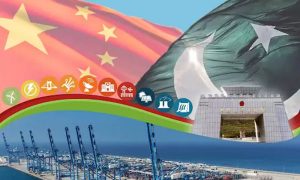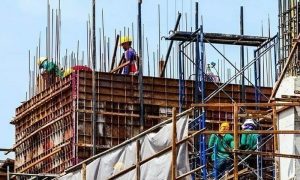Abdul Rauf Alam, President Federation of Pakistan Chambers of Commerce and Industries (FPCCI) has urged the federal government to evolve mechanism and involve private sector in formation of a policy to protect local industries and investors from foreign giant businessmen under China-Pakistan Economic Corridor. He said that the FPCCI also proposed the government to give complete management of economic zones under CPEC to the private sector.
The FPCCI president while launching a report on the CPEC expressed these views in a news conference. He said that the government could not separate the representatives of private sector and main stakeholders of economy from formulation of policy regarding the CPEC. He said that the FPCCI had constituted an advisory committee on CPEC which prepared a comprehensive report. He said that the advisory committee on CPEC has categorized all the ambiguities and controversial arguments in six statements.
Dr Ayub, head of research of FPCCI also gave presentation to the media about the report on CPEC prepared by the advisory committee on CPEC. According to report:
“While granting incentives to Chinese investors and enterprises, the policymakers must not ignore Pakistani investors. Being the representative of private sector and the largest stakeholder of the economy, the FPCCI understands the interests of Pakistani investors and entrepreneurs. We have firm opinion that interests of the local investors must be protected and at least the same incentives should be provided to Pakistanis which have been granted to foreign investors. The interests of the residents of Balochistan and Gwadar should be protected through legislation. The overseas Pakistanis should also be encouraged to invest in CPEC-related projects including investment in industrial zones.”
The report said that FPCCI has strongly emphasized on establishing mechanisms: (i) to protect the local investors; (ii) to boost the indigenous manufacturing industry in Pakistan; (iii) to protect the indigenous peoples and industrialists from hegemony of incoming powerful industrial giants; (iv) to expedite work for completion of the dams in Gilgit-Baltistan; (v) and construction of alternative routes for the peoples who want to avoid the busy corridors.
The report further revealed, “So far as the establishing the economic zones adjacent to the CPEC is concerned, the FPCCI is in strong favor of this idea; however, the incentives to the industries in these zones should not affect the profitability of the existing industries. Particularly, fiscal incentives may affect the investment in other cities. If these incentives are in the form of exemption of direct taxes, they will hit the return on investment because attractive profitable projects will be available in the same sectors in industrial zones. The most adverse impact on the existing units may be in the form of exemption from indirect taxes. We will not recommend any exemption from indirect taxes. If government provides any incentive through exemption from indirect taxes (or reduced tax rates); it should be for all, including old and new units.
Furthermore, we suggest that management of economic zones should be completely managed by private sector as it is the normal practice in industrialized countries. The success of these economic zones is directly related with synchronization on the abovementioned issues and sustainable solution including resolving the energy crisis and maintaining law & order.”
The report said, “Since last several years the government has not announced industrial policy. The government has been emphasizing on demand management policies, where economic management and targets are based on the monetary and fiscal mechanism. The over-dependency on Bretton Woods System is the major cause of emphasizing on demand management policies. The determination of the rate of interest, taxation policies, subsidies and raising the public debts are the major tools of demand management policies. The supply-side polices are required for sustainable growth in the present regime, where much emphasize is required on investment and labor policies. The government should cover the labor, investment, production, energy, education and training, research and development and industrialization in its industrial policy. These are components of the supply side economics which should be incorporated in the industrial policy.”
The FPCCI assures fullest cooperation and expects that in formulation of industrial policy we must be taken in confidence and being the apex representative of stakeholders, our participation in the formulation of economic policies will be ensured by the policymakers.
All the ambiguities and controversial arguments have been categorized in six statements. These statements established the six testable hypotheses, which have been examined by FPCCI research team. Our recommendations are based on this impartial mechanism. These controversial statements are: (i) CPEC is part of a great international power game which has deep-rooted implications for the region. The economic and strategic interests of Pakistan, China, Iran, Afghanistan, Central Asian States, USA and India may be affected. (ii) The corridor will lead the changes in the patterns of industrial and commercial development in Pakistan by means of the new growth centers and urbanization drive in the country. The cities adjacent to the corridor and proposed economic zones will gain the values. Consequently the development ranking of the cities in Pakistan will be changed which will affect the comparative prices of the properties and the patterns of investment in real estate sector in the country. The new industrialized cities and commercial centers will generate the additional capacities for employment creating opportunities also. This view created a ‘Western versus Eastern Route’ controversy. (iii) It will change the ethnic composition of the population in Balochistan because a large-scale internal migration is expected. The changing in development ranking and new employment opportunities in the areas adjacent to the corridor is the main cause of expected relocation of population. It establishes a complementary hypothesis (apprehension) that native residents of Balochistan will not get their due share in the development of Balochistan. (iv) Inflow of Chinese investment and business enterprises will adversely impact the interests of business community in Pakistan. It covers the signing of FTA with China and flooding the Chinese products, in flow of Chinese investment, and migration of Chinese labour to Pakistan. (v) Another contradicted view is that the project is not financially feasible for Pakistan as the country has to pay higher cost of financing because of the unwise negotiations with Chinese investors and over-estimation of project cost. Pakistan has to pay higher cost of services, (vi) and some segments have indicated the element of corruption and bad practices in the project. It indicates that the transparent mechanism was not followed in the negotiations and contracts with the Chinese firms.”
The report further said that according to the FPCCI estimates, the revival of economy and reducing the economic miseries of common peoples are not possible at a GDP growth rate less than 7 per cent. To achieve this 7 percent rate of growth, infrastructure development is the primary requirement. The CPEC is one of the required activities in line with FPCCI recommendations, because it provides the doable modes of resources to develop the required infrastructure.
According to the report, China introduced new development strategy and framework called “One Belt, One Road (OBOR).” The OBOR has six trade corridors spread mainly over Eurasia but touch the fringes of Pacific, North and East Africa. The main corridors: (i) China-Mongolia–Russia Corridor (ii) New Eurasian Land Bridge (iii) China–Central Asia–West Asia Corridor (iv) China–Indochina Peninsula Corridor (v) China–Myanmar–Bangladesh–India Corridor and (vi) China–Pakistan Economic Corridor (CPEC). It is expected that within a decade China’s annual trade with OBOR countries will exceed $2.5 trillion and it will become 1/3 of the world GDP and 1/3 of the services and goods








